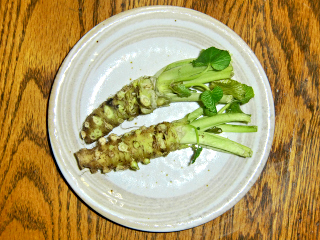Food culture in Japan cannot miss the wasabi as sushi, sashimi a spice of soba and etc now. It is come to root in the life of people so as to be called as “wasabi” in Australia.

The wasabi was originally from Japan and originally used as a medicinal herb from wasabi grown naturally. It is said that it is from vegetarian meal of the Kamakura era that it is come to use as food. The cultivation of the wasabi began in the Edo era around Shizuoka prefecture, too.

▲wasabi flower

The characteristic of the wasabi is a unique sharp taste. Sterilization effect and more than ten kinds of fragrance ingredients are included in this sharp taste ingredient. In addition, there is the effect such as follows:
| Anti-aging Action |
With increase of the antioxidant power in a whole body, get rid of active oxygen causing the aging |
|
Brain Cell Reproduction |
Promote the reproduction of the cranial nerve cell and can expect improvement of a memory, the learning ability (by the mouse experiment) |
| Anticancer Action |
Detoxification promotion. Control chromosomal abnormality and protect a body from a radiation to cause carcinogenesis and mutation. |
|
Thromboprophylaxis Action |
Control the platelet aggregation, and prevent blood clotting strongly and make smooth blood flow, and prevent arteriosclerosis. In the case of Wasabizuke (wasabi preserved in sake lees), combined with an ferment of the sake lees, the effect improves more. |
| Bactericidal Action |
Food poisoning and the mold prevention. There is a strong sterilization effect for O-157, Vibrio parahaemolyticus and staphylococcus. A lunch becomes hard to rot when wipe the cover of the lunch box by a cut end of the wasabi . |
|
Prevention of Diarrheal |
Can be expected the prevention f diarrheal to control chlorine ion secretion with the intestinal mucosa. |
|
Anti Nematode Action |
Effective in stopping the activity of nematode which is parasitic on seafood. (The wisdom of ancient people!) |
|
Appetite Increase Action |
The appetite increases by the colour and the sharp taste of wasabi. Raise permeability in the combination between the digestion stem cell and promote digestion and absorption. |
Taking in 12.5g of wasabizuke (wasabi preserved in sake lee) or 20g of wasabi every day is good to get these effects.

■ Recipes
Let’s get the effect above of the wasabi deliciously!
► Tossed Crab Sticks with Wasabi Mayonnaise
• 5pcs 18cm Crab Sticks
• 100g Enoki Mushrooms
• 100g of White Radish Sprout (or favourite sprouts)
• 1 tbsp Concentration Dashi Soup
• 1 tbsp Mayonnaise
• ½ tsp Grated Wasabi
1. Cut off Enoki mushrooms hard tip, and then cut them into half and loosen them.
Place them on a heat proof container and microwave (600W) for
approximately one minute and 20 seconds. Wash in water and squeeze
moisture well, and toss with concentration soup.
2. Tear crab sticks thin; cut off white radish sprout root; mix with enoki
mushrooms.
3. Mix wasabi and mayonnaise, add the sauce into the crab sticks mixture and toss
well.
► Wasabi Flavour Mashed Potato
• 400g Potatoes
• 40g Unsalted Butter
• 1/3 cup (80 ml) Fresh Thin Cream
• 3 tbsp Grated Wasabi
• Little Salt and Pepper
1. Before turn on the heat, place potatoes into scold salted water,
and then turn on the heat and bring to the boil.
Keep boiling for approximately ten minutes until cook through.
2. Let the moisture of potatoes drain off well, and mush them.
3. Place butter and cream in a pot on a low heat.
When the butter melts, put potato mash and wasabi, and stir well until
smooth and creamy.
4. Season with salt and pepper to taste.
Because a sharp taste decreases when the wasabi was heated, to mix it with soup, okonomiyaki pancakes and tempura powder is recommended.
Give a try!
★visit ICHIBA JUNCTION now!



